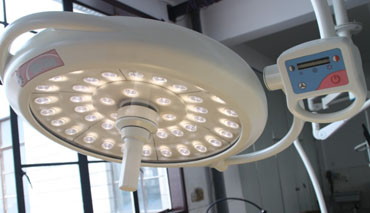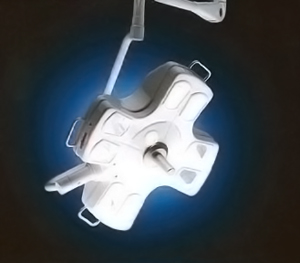Categories
Surgical Lights: from the Beginning up to This Day

Surgical light is also called operating light or a surgical lighthead. It is used to illuminate patient’s cavity or local area during the operation. In case a few surgical lights are used it is called a ‘surgical light system’.
The history of surgical lighting dates back to 1850s. The operating room had windows in the ceiling and was built towards the south-east. It was very inconvenient because the medical personnel or equipment could block the light, and the weather conditions could be unfavorable. Later on, the mirrors were placed on the corners of the ceiling so that they could reflect the light.
With the appearance of electric lights, the problem was partially solved. However, the first lights created great heat radiation and the emission of light was hardly controlled.
When light-emitting diodes (LED) were introduced, the problem of heat radiation was solved. Besides, such surgical lights consume less energy.
LED Surgical Lights

LED technology has a significant potential for energy savings and little maintenance. Compared to halogen lamps, LED surgery lights do not require filters to reduce the emission of non-visible radiation. Besides, halogen lamps work for 1000-3000 hours and fail suddenly without warning. LED lights work for 25,000-40,000 hours. When the lamps fail, they gradually fade.
Surgical LED lights have several more benefits:
- they radiate little ultraviolet or infrared energy;
- less voltage is necessary in order to produce equivalent light levels;
- one can use dimming with no change in color or flicker, and it can yield energy savings;
- LEDs decrease shadows cast ;
- some products offer color adjustment.
However, LEDs have a few disadvantages:
- LEDs must be used away from substantial thermal energy;
- such kinds of lamps are relatively expensive;
- independent test data are not generally available.
The medical personnel must make thorough examination of LED surgery lights and review work instructions before use.
Burton Surgical Lights

Philips Burton was launched in 1928. The company is a manufacturer of medical equipment. Philips Burton has designed, produced and distributed high-quality examination, and surgery lighting devices for more than 80 years. More than 250,000 Philips Burton lights are installed in the USA. The products are famous for high quality and reliability. Besides, each one has 5-year warranty.
Philips Burton is a part of Royal Philips. Its location is Franklin Park, Illinois, west of Chicago.
Philips Burton is FDA-registered. The products meet all FDA requirements, as well as UL and CE certification standards. Philips Burton manufacturer is certified as an ISO 13485 facility. Its products meet certified standards for European and the U.S. markets.
As a company network and independent sales representatives distribute Philips Burton products all over the world, the brand is highly recognized. The most popular products are AIM LED, Nova Exam LED, Nuance Elite, Super Exam 50 LED, etc.
ALM Surgical Lights

ALM is a world leader of surgical lighting systems. It has a network of distributors and sales representatives in over 50 countries. Furthermore, ALM has sales companies in the UK, the USA, France, Spain, Italy, and China.
ALM has headquarters and final assembly facility in Ardon near Orl?ans. In 2001 ALM’s global market share for surgical lights was 20%. That year the company was acquired by Getinge. Being a part of Getinge Group, MAQUET cooperates with ALM; that is why ALM surgical lights are often produced under the MAQUET brand. New ALM products have the following features:
- maximum illumination with minimum eye fatigue;
- true rendition of color;
- highly efficient heat control system;
- uniform light distribution;
- shadow control;
- compact shape of surgical lamp;
- light suspension system;
- camera providing procedure documentation, video-conferencing, and education;
- touch panel or remote control of light intensity;
- ambient light for minimally invasive surgery.
To sum it up, the technologies are developing rapidly. The design and features of surgical lamps are changing, so more and more products appear. You can easily choose the right lights according to your needs.



